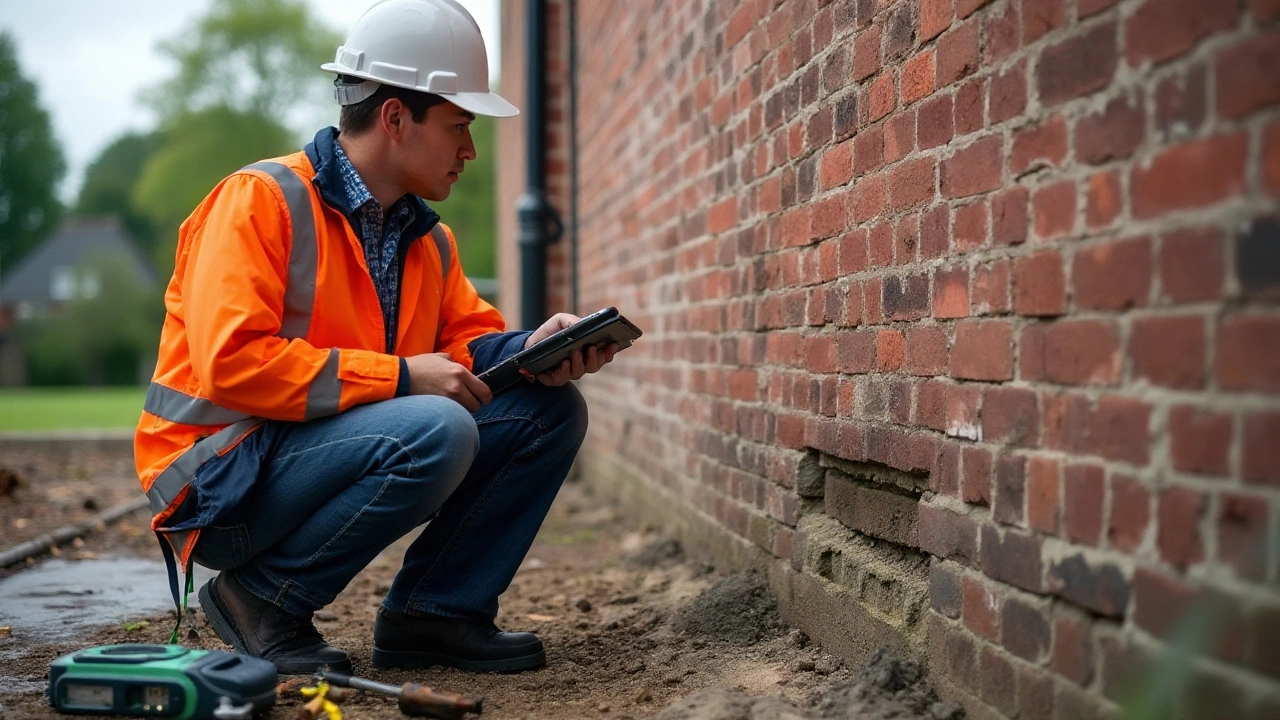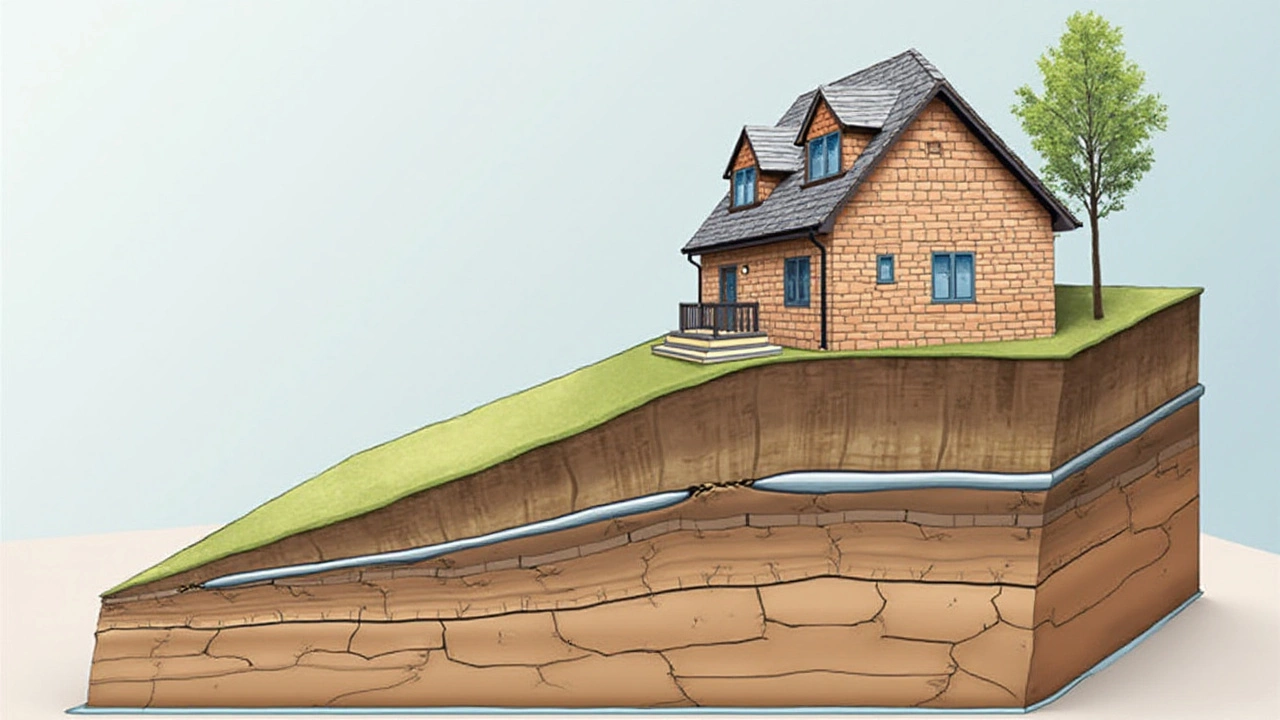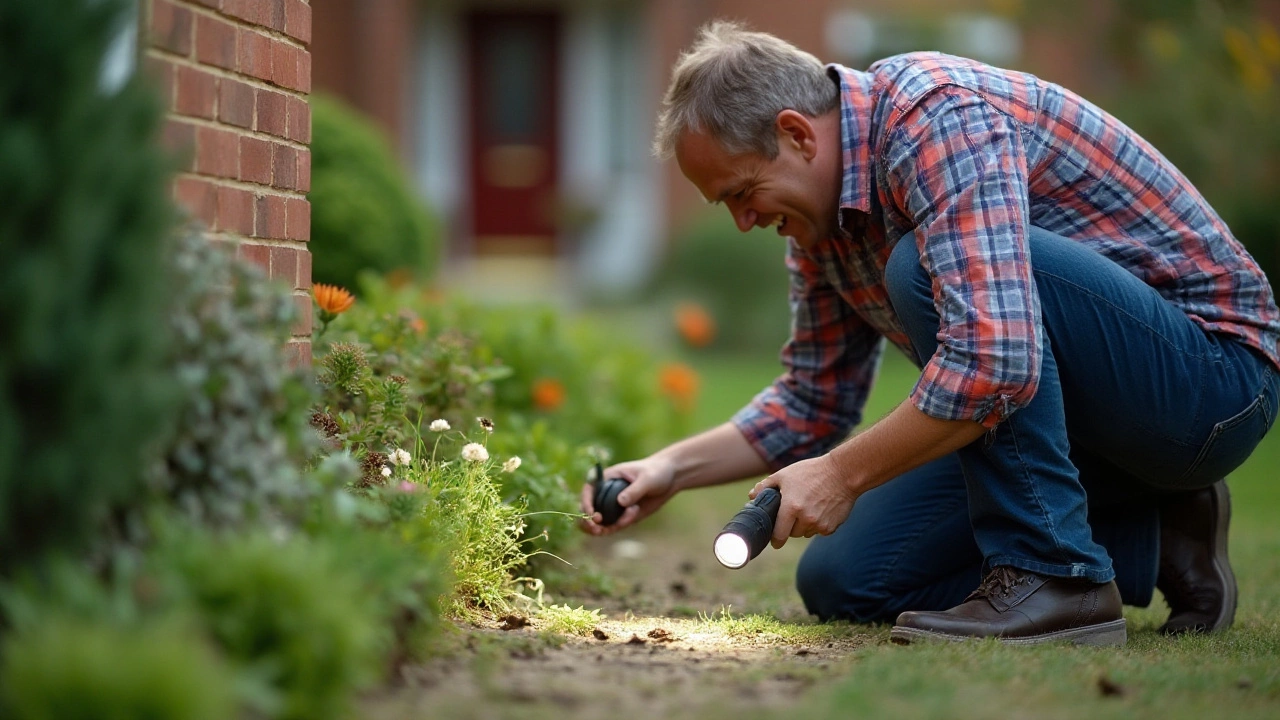Foundation cracks can be a homeowner's nightmare, especially when they appear horizontal across the wall. Such cracks are typically more concerning than their vertical cousins. They often suggest there’s a much bigger problem lurking under your home.
The root causes of these cracks can vary, ranging from pressure applied by hydrostatic forces in overly saturated soils to freezing, thawing cycles that expand and contract materials. It's important to identify and address the issue as soon as possible to avoid future structural instability.
This article will delve into the causes and implications of horizontal foundation cracks, how to spot the early warning signs in your home, and the steps you can take to repair them effectively or even prevent them from forming in the first place. Whether you’re a seasoned DIY enthusiast or someone who prefers to call in the professionals, understanding these basics will arm you with the knowledge you need to protect your home’s foundation.
- Causes of Horizontal Foundation Cracks
- Implications for Structural Integrity
- Identifying Problem Signs
- Repair and Prevention Strategies
- When to Call a Professional
Causes of Horizontal Foundation Cracks
Horizontal foundation cracks are often a cause for concern because they typically mean that there is lateral pressure being exerted on the foundation wall. A common source of this pressure is expansive clay soil. When these soils absorb water, they swell and increase in volume, exerting significant force against foundation walls. During dry periods, they contract, but if the pressure during the swelling phase exceeds the structural limits of the wall, it can cause it to crack horizontally.
Another major culprit is hydrostatic pressure, which arises from water buildup in the soil surrounding the foundation. This often occurs following heavy rains or in homes located in areas with poor drainage systems. When water accumulates, it increases the weight of the soil, which leads to pressure being applied against the walls of the foundation. Over time, this pressure can surpass the design capacity of these walls, resulting in horizontal cracks.
Additionally, poor construction practices can also contribute to horizontal foundation cracks. When foundations are not built to adhere to local building codes or engineering standards, the materials may not be strong enough to withstand lateral pressures from the soil. In regions prone to frost, the concept of frost heave can be at play. This process occurs when water in the soil freezes and expands, pushing against the foundation. It’s also worth considering that homes constructed on sloped terrain can experience increased pressure on one side of the foundation, leading to a higher likelihood of horizontal cracking.
According to a study published by the American Society of Civil Engineers, inadequate waterproofing and drainage systems were found to be significant factors in foundation wall failures.
In some cases, horizontal cracks emerge due to seismic activity or vibrations from nearby construction work. While seismic tremors may not be common everywhere, when they do occur, they can cause shifts in the ground that put unexpected pressure on a structure's foundation. Similarly, construction work or even heavy traffic can cause the ground to vibrate, stirring the earth surrounding a foundation and potentially leading to cracks. To better understand how these different factors play a role, take a look at the following data:
| Cause | Frequency in Foundation Issues (%) |
|---|---|
| Expansive Soil | 40 |
| Hydrostatic Pressure | 35 |
| Poor Construction | 15 |
| Seismic Activity | 5 |
| Frost Heave | 5 |
Implications for Structural Integrity
Horizontal foundation cracks are more than just an aesthetic issue; they are a warning sign of potential structural problems. The presence of these cracks often indicates significant lateral pressure on the foundation walls. This pressure can stem from various sources, such as waterlogged soils which exert force when expanded. Unlike other crack types, horizontal ones typically suggest that there is an active stress affecting the wall's structural integrity.
One of the primary concerns with these cracks is the potential for a complete wall failure. When left unchecked, the pressure may cause the wall to bow or even collapse, compromising the safety of the building. In homes with basements or crawlspaces, this can lead to severe consequences such as water infiltration, increased humidity, and even pest infestations, as weak points in the structure provide easy access for water and creatures.
Another implication of ignoring these cracks is the cascading effect they have on other structural components. For instance, they can disrupt the alignment of door frames and windows, making them difficult to operate and reducing the home's energy efficiency due to draft issues. Moreover, misalignment caused by compromised foundations can result in uneven floors, which not only diminish the property's aesthetic appeal but also pose tripping hazards and risk injury to occupants. This misalignment can even extend upwards, affecting the roof's stability and increasing the risk of leaks or sagging.
The structural integrity of a home relies heavily on a sound foundation. With horizontal cracks present, homeowners need to consider the potential decrease in property value. Potential buyers or home inspectors may identify these cracks as immediate red flags, leading to reduced offers or the necessity for negotiating major repair costs. This unfavorable perception can linger in the housing market, affecting resale opportunities and homeowner equity significantly.
Addressing these issues requires both a proactive approach to maintenance and effective repair strategies. Regular inspections can help in early detection, while professional evaluation ensures accurate identification of the underlying causes. Early action can prevent more extensive damages and protect the value and safety of the home. In the words of a respected structural engineer, “A crack is never simply a line; it’s a story of the forces at play beneath your feet.”
Foundation integrity isn’t about concrete; it’s about safeguarding your most valuable investment—your home.”

Identifying Problem Signs
Recognizing the warning signals of horizontal foundation cracks at an early stage can dramatically reduce the risk of structural damage, but spotting these signs isn't always straightforward. Homeowners should pay attention to several key indicators that may suggest their foundation is under stress. One common sign is the presence of visible cracks, not only in the foundation itself but also in the interior and exterior walls. These cracks typically run parallel to the floor and can vary in width. They often appear for the first time or expand during periods of heavy rain or significant temperature shifts. If you notice a crack that seems to get worse over time, it’s time to consider an expert evaluation.
Aside from the visible cracks, homeowners should be wary of additional symptoms that might indicate foundation problems. Windows and doors that jam or fail to latch properly might signal a shifting foundation. Floors that appear to be uneven or sloping are another indicator of potential trouble. Many homeowners incorrectly attribute these symptoms to normal settling, but when combined with wall or ceiling cracks, they can point to more severe issues. It's crucial to monitor these abnormalities as they can escalate rapidly if ignored.
An often overlooked sign is the presence of moisture in the basement or crawl spaces. High moisture levels can cause soil expansion, which exerts pressure on the foundation and may result in horizontal cracks. Musty odors and water stains are telltale signs of an ongoing moisture problem. In a statement to housing experts, engineer Mark Haynes noted,
"Homeowners need to consider moisture levels as a primary factor when assessing potential structural issues. Excessive dampness isn't just a minor inconvenience; it’s often a precursor to serious discussions about foundation integrity."
If you suspect an issue, conducting a thorough inspection of your home can provide valuable information. When walking around your house, take note of any decorative molding or baseboards that appear separated from the wall. This gap might not seem significant, but it indicates movement within the home’s structure. Furthermore, when turning over carpets or peeling back wallpaper, check for uneven surfaces or buckling, as these might be foundational shifts manifesting on the surface. By being proactive and attentive to these various indicators, you protect your home’s long-term health and discover potential problems before they necessitate more drastic, costly interventions.
For the tech-savvy homeowner, utilizing technology like structural sensors can be a wise investment. These devices quietly monitor any shifts within your home’s foundation, providing real-time updates and peace of mind. It’s a forward-thinking approach to preventative care and can even offer a tangible return on investment by catching issues early. Indeed, with proper maintenance and vigilance, many of these problems can be identified and resolved before they develop into something much more serious, preserving both your peace of mind and the structural integrity of your beloved home.
Repair and Prevention Strategies
Addressing horizontal cracks in your home's foundation requires a careful balance between repair and prevention. Not only are these cracks an aesthetic blemish to the structure of your home, but they also threaten its very stability. When it comes to repair, one of the first steps is to evaluate the extent of the damage. This can be tricky because what looks like a surface crack may run deeper into the foundation, compromising the entire structure. Early intervention is key. Employing professional help can be beneficial in such cases, as experts can recommend whether patching, underpinning, or installing wall anchors will suffice, or if a more extensive fix is necessary.
An effective strategy often involves installing drainage systems such as French drains that help redirect water away from the home's foundation, reducing the hydrostatic pressure that typically causes these foundation cracks. Adding or adjusting gutters and downspouts can also help in diverting rainfall away from the base of your house. Remember, water management is a critical component in maintaining the integrity of your foundation.
Sealing the cracks with injection epoxy or polyurethane foam is one of the common repair methods. This technique, although useful for waterproofing, needs to be applied meticulously to ensure that no water seeps in, which could worsen the problem. Repair does not end with sealing; observing your foundation after repairs to monitor any subsequent movement or crack formation is crucial.
"It is important to address cracks promptly, not only to avoid costly repairs but also for the safety and integrity of the structure," advises the Concrete Foundations Association.
Preventive measures aren’t just about dealing with cracks after they’ve occurred; they also mean adopting routine inspections of your home’s foundation. Seasonal changes can also play significant roles; hence, regularly checking your foundation during and after rainy seasons or winters can prevent minor issues from becoming substantial problems. Be sure to maintain a consistent soil moisture level around your home. Large swings in soil moisture—thus swelling and contracting—can lead to pressure on the foundation walls.
If you're tackling this yourself, it's a good idea to begin with a complete visual inspection around your home. Look for bowing walls and jamming doors or windows, which are often indicators of underlying issues. If you notice any signs of distress, act promptly by reaching out to structural engineers or contractors experienced in foundation repair. Often, having the expertise of someone familiar with various soil types and local climatic conditions is invaluable. Recovery and reinforcement of a foundation require not just immediate action, but a long-term maintenance plan.
Using resilient materials like fiber-reinforced concrete for major reparations isn't just a short-term fix but a long-term investment in the longevity of your property's foundation. It’s also worth considering incorporating flexible materials and design elements that can tolerate minor shifts, particularly if you know soil and weather conditions in the area often lead to such challenges. This way, you'll not only protect your investment but ensure the safety and comfort of your family for years to come.

When to Call a Professional
While some issues with foundation cracks might seem minor at first glance, horizontal cracks demand a greater level of scrutiny and urgency. If you notice horizontal cracks in your foundation, it’s essential to assess the situation promptly. Horizontal cracks are often indicative of severe structural damage, as they signify external pressure, such as hydrostatic pressure from saturated soils, that could compromise the integrity of your entire home. This isn’t just cosmetic—it’s about critical structural strength and safety.
When deciding if it’s time to contact a professional, consider the size and the widening rate of the cracks. Generally, if a crack is wider than one-eighth of an inch or shows signs of movement, this is a red flag you shouldn't ignore. The urgency increases if the cracks make a stair-step pattern or extend into basement walls, which may indicate the foundation is under considerable stress. Such scenarios often need advanced diagnostics that only a professional can provide efficiently and accurately.
Determining Severity
A structural engineer or a specialized foundation repair company possesses the tools and expertise to evaluate the severity of the problem accurately. They may employ a range of techniques, from simple field inspections to more sophisticated approaches using sensors and pressure gauges, to understand the extent of the foundation's distress. These assessments can help pinpoint the immediate cause, whether it’s poor drainage, expansive clay soils, or other environmental factors.
According to the National Association of Home Builders, "Ignoring horizontal cracks can lead to more profound structural deterioration, especially in regions prone to heavy rains or snowfall."
Acting quickly on a professional assessment can be the difference between a relatively manageable repair and a much larger, costlier project. Professionals often advise on remediation steps that could include stabilizing the foundation, improving drainage, or even underpinning to halt further damage and bolster your home’s longevity.
Professionals Offer Tailored Solutions
An experienced contractor can provide a tailored solution that fits your specific needs and budget. After assessing your home’s condition, they can suggest appropriate techniques like installing wall anchors, carbon fiber strips or steel I-beams, to reinforce the affected areas. Some methods might be less invasive and disruptive than others, allowing for a more seamless repair process. Regardless of the technique, addressing foundation repair proactively can prevent future expenses and ensure your family’s safety.
Another critical aspect to consider is that professional repairs often come with a warranty or guarantee, which can offer peace of mind. Ensuring the issue is addressed correctly the first time can save money and stress in the long term. By contacting the right professional early on, homeowners can mitigate damage, stay informed about potential environmental impacts, and protect their most valuable asset—their home.





